Make Hiking Less Tiring With These Simple Strategies
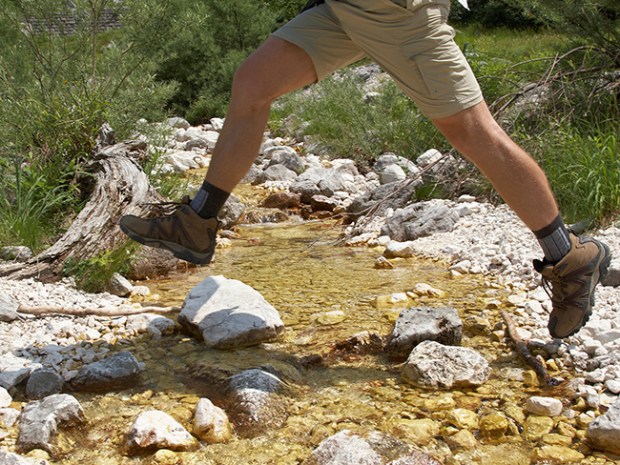
Up one hill and down another: Before you know it, your pack weighs a ton and you’re panting like a dog. But a hike does not have to be this tiring. A steady pace will conserve energy by ironing out all those ups and downs.
FIND YOUR STRIDE
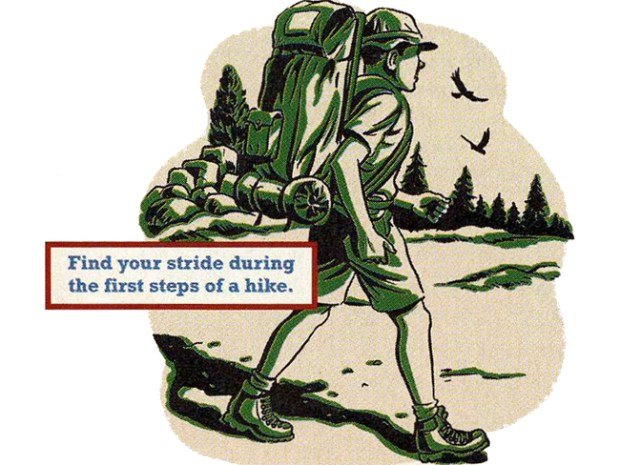
Everyone has a different stride (natural pace). Find yours during the first steps of a hike. It should be smooth — with rhythmic breathing, swinging arms and a consistent length to the step.
Maintaining that pace can be difficult. Slower hikers ahead on the trail slow your pace. Faster ones tempt you to hurry along.
Spreading out your group helps you maintain your pace. But for safety, your pace can’t be any faster than the slowest hiker in your group. It’s important that the group stay together.”
If not, when Scouts come to a fork in the trail they’ll get separated. And if a problem arises with hikers at the rear, the ones in front won’t know about it and will keep going.
HEADING UPHILL …
Shorten steps on steep portions of the trail but still retain your rhythm.
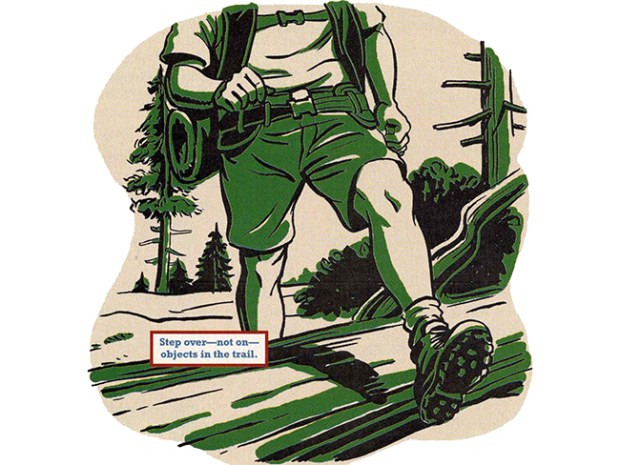
Also, step over objects in the trail instead of stepping on them. Stepping up on logs and rocks in the trail all day is like climbing an extra thousand feet straight up.
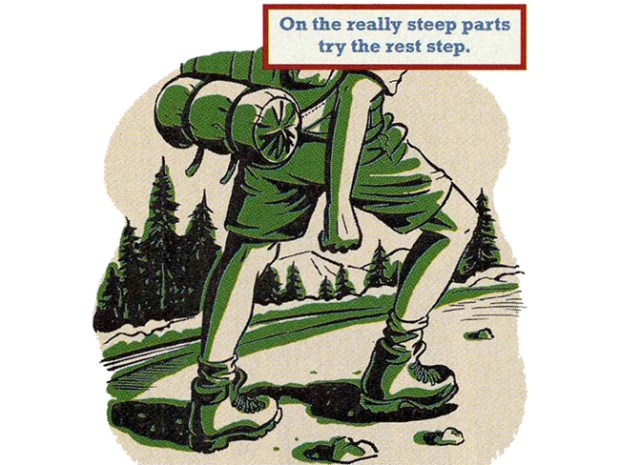
On the really steep parts of the trail, try a rest step. With each climbing step, straighten either the forward or trailing leg and lock the knee. Pause for a second, letting the bones of the locked leg bear your weight. This gives the leg muscles a short rest between steps.
… AND BACK DOWNHILL
The uphill struggle is rewarded with a downhill coast. But stay in control. Experts say they see way more injuries to hikers going downhill because they’re not in control.
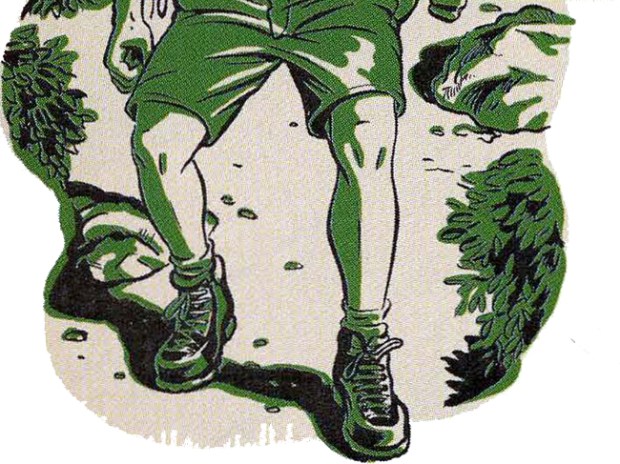
A slight bend in the knees absorbs the shock to the feet and leg joints when coming downhill. Placing the feet flat on the ground provides more boot sole surface to grip the ground.
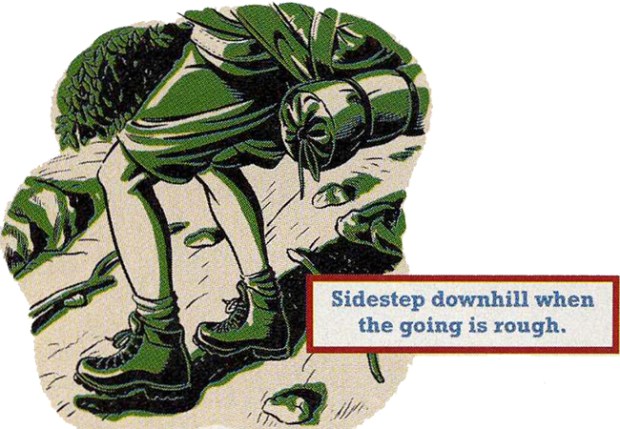
If the going’s real rough you might even want to side-step down the trail.
REST FREQUENTLY BUT NOT TOO LONG
Time between rest stops varies. In dry conditions or in areas with elevation changes, you may want to rest every 20 or 30 minutes. No matter what, try to stop at least every hour to readjust packs and drink some water.
Limit rests to five minutes or so. Any longer and muscles tend to tighten, making it harder to resume your hiking rhythm.
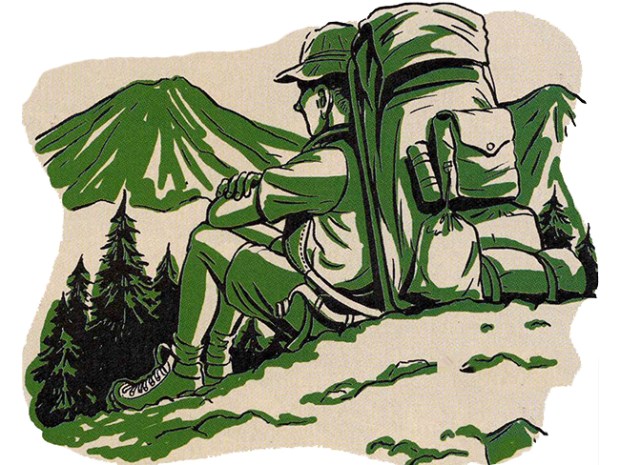
Sit and give your feet a break while resting. Face downhill so your pack rests on the ground, not on your aching back.
Leave the pack on, but loosen the hip belt and shoulder straps. That eliminates lifting the pack and struggling back into the belt and straps.
With a break and a drink, you’re ready to hit the trail again with a steady step.
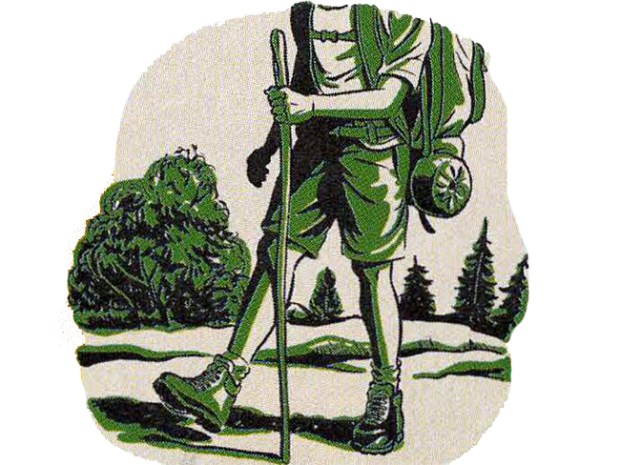
USE A WALKING STICK FOR ROUGH SPOTS
A walking stick lends a supporting hand while crossing streams or rough spots on a trail. Many hikers use the enduring wooden staff.
Modern trekking poles made of metal and/or plastics are lighter and provide a molded grip. Some hikers clutch a trekking pole in each hand. The swinging poles help help keep a fluid pace.
You can carve your own wooden walking stick. Click here to find how-to plans for creating your own.
typo where it says help help keep a fluid steady pace
Great advice! It’s also really important that everyone’s pack is fitted comfortably. I also recommend wool socks and liners to prevent hot spots.
Never give up high ground unnecessary
One thing to also mention is climate and altitude . They can effect your performance in a negative way if your not accustom to extreme conditions. Buffalo Trails is mile-high + , very dry and steep ! This was my backyard as a boy and I considered it a heavenly place to be at ! Thanks for you web site !
I wish i had used this at Philmont. If you guys go to Philmont us this. TRUST ME, I wish I had. Does anyone know who won the ipad? PLEASE RESPOND I AM DESPERATE TO KNOW!!!!!!!
This is DEFINITELY going to help me!
This is gonna come in really handy!
Well I will surly use these tips because I really like to hike
this is a graet way to get ready
One way to keep a steady and enduring pace while hiking either a ten mile hike or a twenty mile hike is to keep each individual hikers favorite song which maintains a sixty beat per minute musical meter (like Row, Row, Row Your Boat Gently Down the Stream and so on) and advance each hiking step to one beat of the song for the entire length of the hike–the favorite song doesn’t have to be sung out loud, but if the song is maintained for the entire hike, the hiking pace is steady, constant and the hiker usually enjoys the hike more than a grudgingly here we go again on a “ten mile hike or twenty mile endurance hike”.
WOW thanks we went hikeinhg in the smoky mountains and these were really useful.
This helped
im going on a back packing trip with my troop this summer in new mexico. im really happy i saw this as im starting to work out for our trip ahead. I hope this tip pays off this summer
A good thing to do before trips to philmont or any other place is to do shake downs. I am going to isle royale this summer and we have 6 shake downs where you can get a good pace.
and before a trip you should do some strength traing like going out for a 45 minute run
though hiking boots are good 4 multi day hikes. 4 short 7 mile day hikes in good wheather i prefer to use my mizuno running shoes they provide support for me plus i have strong ankels and they are comfortable.
Use hiking boots with sturdy ankles.
Don’t drink soda for two or three days before the hike, it helps prevent cramps. Also, when you begin to breath hard try breathing in through your nose and out your mouth.
How does that help?
Good advice! Regular exercise before hiking helps too. Step exercises help me.
I am going to philmont in a year these are good tips I can start practiceing and get really good at
Thanks for the tip!
Please do an article on hiking boots. What’s good and what’s bad.
I had just came back from philmont last week and if this article came out sooner it would of really helped me. It was really strenous trying to cope with the eelevation. One day when i was there we hiked 15 miles. It was a lot of work but really fun. Philmont is the best.If you have the chance to go you should do it.Thanks!
-PhilmontGuy22
The rest step really works. My boss guides trips in addition to his normal day job, and when he goes to Denali he teaches everyone the rest step. Everyone gets to the top, and the rest step is really what saves them.
Thanks for the tip!
nice tip
why didn’t they have this site before. I just went to buffalo trails for my first year and boys always get tired so quickly. A hint to new patrol leaders read this and tell your patrol so they might complane less
I am going to Grand Canyon in a week these will help
a
Egad! Never, ever step over a log on a trail. I don’t know how the rattlesnakes at Philmont behave, but if you step over a log down South you’re apt to step onto a water moccasin. It won’t be pleasant for either of you.
You’ve provided some very good and useful advice here. I’ve been around Scouting for years. I earned Eagle Scout in about 1965. I hiked alot at Camp Geiger near St. Joseph, MO. I really appreciate my experience as a member of Tribe of Mic-O-Say. My first year at Camp Geiger, my Mom bought me a new pair of boots that weren’t broken in. I know she meant well, but I sure got a lot of blisters. Make sure your boots fit well and are well broken in before you go to camp or on a long hike, and follow the advice provided here. Mr. Haviland knows what he’s talking about!
I learned that a long time ago!!!!!!!!!!!!!!
This is really useful! I am going to Philmont next year, and am proud to say my crew and I are dong these things. Thanks, BL!